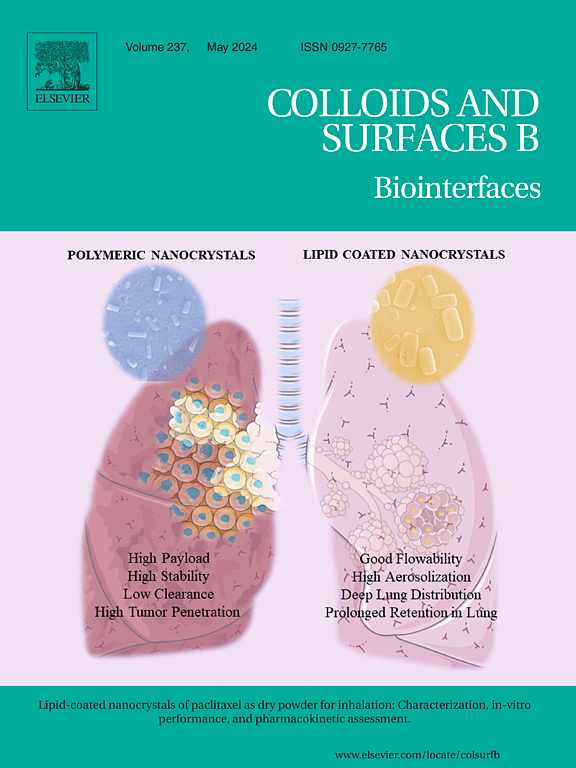界面/关闭:新型表面活性剂和蛋白质在固液和油液界面上的竞争吸附特性
IF 5.6
2区 医学
Q1 BIOPHYSICS
引用次数: 0
摘要
生物制药中遇到的界面应力通常通过在其配方中使用表面活性剂来对抗。表面活性剂通过屏蔽界面或取代吸附的蛋白质来保护蛋白质免受这种压力。大多数先前的研究都致力于气液界面,并表征单克隆抗体或与已建立的表面活性剂(聚山酸酯和poloxam188)结合的非药物相关蛋白质。本文采用石英晶体耗散微天平(QCM-D)和张力测量法研究了三种不同模式生物治疗药物存在和不存在时,已有表面活性剂以及新型表面活性剂VEDS和VEDG-3.3在固液界面和硅油液界面的吸附行为。我们的研究表明,个体吸附行为是分子依赖的,正如预期的那样。当同时混合(共吸附)或顺序混合(屏蔽和置换)时,检测到蛋白质和表面活性剂在界面上共同吸附。与已建立的表面活性剂相比,VEDS和VEDG-3.3表现出较慢的吸附,随后的分子重排导致更致密的堆积,这支持了先前报道的它们有利的蛋白质稳定作用的机制解释。总的来说,我们的结果支持在药学相关条件下对蛋白质-表面活性剂混合物吸附的统一热力学描述。本文章由计算机程序翻译,如有差异,请以英文原文为准。
InterFace/Off: characterization of competitive adsorption of novel surfactants and proteins at the solid-liquid and oil-liquid interfaces
Interfacial stress encountered by biopharmaceuticals is often opposed by employing surfactants in their formulations. Surfactants protect proteins from this stress by either shielding the interface or displacing adsorbed proteins. Most previous studies were dedicated to the air-liquid interface, and to characterize monoclonal antibodies or non-pharmaceutically relevant proteins in combination with established surfactants (polysorbates and poloxamer 188). Herein, we employ quartz crystal microbalance with dissipation (QCM-D) and tensiometry to investigate the adsorption behavior of established surfactants as well as the novel surfactants VEDS and VEDG-3.3 at the solid-liquid and silicon oil-liquid interfaces in presence and absence of three model biotherapeutics of different modalities. Our study shows that the individual adsorption behavior is molecule-dependent, as expected. When mixed either simultaneously (co-adsorption) or sequentially (shielding and displacement), both proteins and surfactants were detected to co-adsorb at the interface. Compared to the established surfactants, VEDS and VEDG-3.3 showed a slower adsorption followed by molecular rearrangements that resulted in a denser packing, supporting the mechanistic explanation of their favorable protein stabilization effect previously reported. Collectively, our results support the generation of a unified thermodynamic description of the adsorption of protein-surfactants mixtures in pharmaceutically-relevant conditions.
求助全文
通过发布文献求助,成功后即可免费获取论文全文。
去求助
来源期刊

Colloids and Surfaces B: Biointerfaces
生物-材料科学:生物材料
CiteScore
11.10
自引率
3.40%
发文量
730
审稿时长
42 days
期刊介绍:
Colloids and Surfaces B: Biointerfaces is an international journal devoted to fundamental and applied research on colloid and interfacial phenomena in relation to systems of biological origin, having particular relevance to the medical, pharmaceutical, biotechnological, food and cosmetic fields.
Submissions that: (1) deal solely with biological phenomena and do not describe the physico-chemical or colloid-chemical background and/or mechanism of the phenomena, and (2) deal solely with colloid/interfacial phenomena and do not have appropriate biological content or relevance, are outside the scope of the journal and will not be considered for publication.
The journal publishes regular research papers, reviews, short communications and invited perspective articles, called BioInterface Perspectives. The BioInterface Perspective provide researchers the opportunity to review their own work, as well as provide insight into the work of others that inspired and influenced the author. Regular articles should have a maximum total length of 6,000 words. In addition, a (combined) maximum of 8 normal-sized figures and/or tables is allowed (so for instance 3 tables and 5 figures). For multiple-panel figures each set of two panels equates to one figure. Short communications should not exceed half of the above. It is required to give on the article cover page a short statistical summary of the article listing the total number of words and tables/figures.
 求助内容:
求助内容: 应助结果提醒方式:
应助结果提醒方式:


